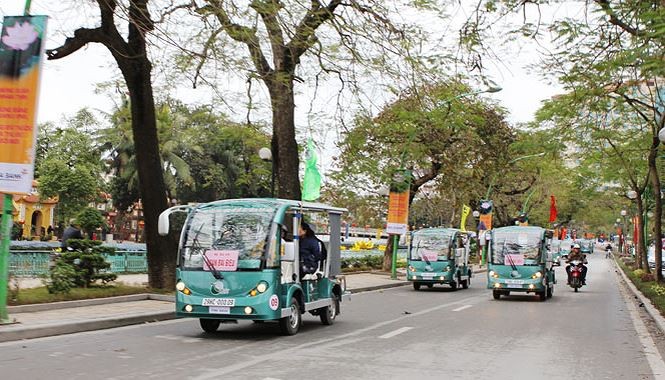 Electric cars carry visitors around West Lake.(Photo: tienphong.vn) Electric cars carry visitors around West Lake.(Photo: tienphong.vn) |
An electric car tour is one of the best ways to explore West Lake. The tour departs at 8:30 each morning. The 18-kilometer trip to 21 destinations around the lake starts at the Ho Tay water park. A winding road takes visitors past lotus ponds and ancient buildings. The car goes slowly, enabling visitors to breath in the lotus fragrance and enjoy the lake view.
“I’ve been living in Hanoi a long time but this is the first time I have taken a West Lake tour in an electric car. I enjoy the cool air very much, as well as the ancient temples and pagodas. I think the electric car is an ideal vehicle for exploring this area. I used to go here by taxi or motorbike but I couldn’t absorb the details as I do in this electric car,” said tourist Tran Hai Nam said.
Mai Xuan Cuong was born and has lived in Hanoi for 30 years. He always thinks he knows this city like the back of his hand but it turns out not to be the case. The electric car tour of West Lake takes him to places he’s never seen before.
“I live near West Lake but this is the first time I’ve travelled a complete circle around it. There are some things totally brand new to me like the Yen Phu fishing village. I love the clean environment and feel peaceful in my soul,” said Cuong.
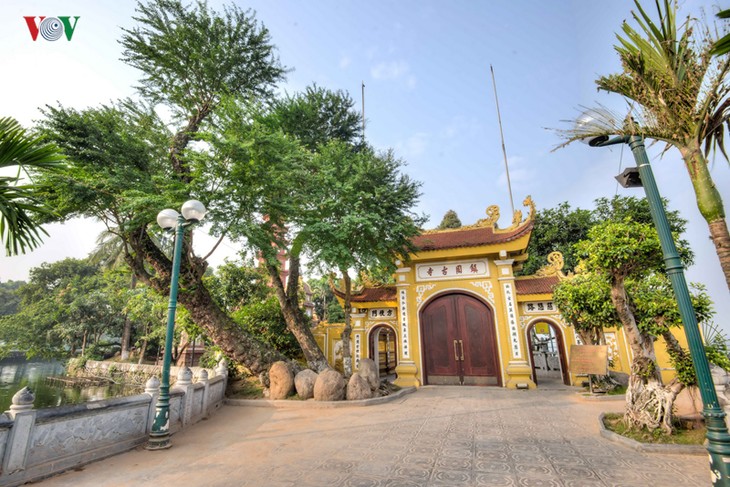 Tran Quoc pagoda lies on an islet east of West Lake. Tran Quoc pagoda lies on an islet east of West Lake. |
One of the electric car tour’s destination is the Kim Nguu temple, honoring the Golden Buffalo god. A folk story claims that the original name of the lake was “Golden Buffalo lake”, because it was formed by the struggles of a buffalo after the disappearance of her calf. Other notable stops are Vong Thi temple, Tran Quoc pagoda, Kim Lien pagoda, Tay Ho temple, and the Trich Sai communal house, which we will visit later in the show.
The tour also includes Hanoi food specialties and traditional crafts. Nguyen Cong Uan, Director of the TLC West Lake Joint Stock Company – the operator of the electric car tour – said: “This tour shows you how lotus scented tea and wine are made, and lets you sample ‘banh tom’ or shrimp cakes and ‘bun oc’ or snail noodles, which are especially delicious in winter.”
 Lotus flowers are picked up early in the morning around 5 a.m to make scented tea. Lotus flowers are picked up early in the morning around 5 a.m to make scented tea. |
West Lake provides the essential ingredient for Hanoi’s famous lotus tea. Making lotus tea is time-consuming and complicated. Although lotus flowers can be found almost anywhere in Vietnam, lotus from West Lake has long been regarded as the best for scenting tea. The West Lake lotus, called “hundred-petal lotus”, has a special fragrance that lotus from other places can’t match. The lotus flowers must be picked in the early morning, when the dew is still heavy, in order to ensure the tea's freshness.
Ms Nguyen Thi Tuyet, who has made lotus tea for generations, describes on how to scent the tea in the traditional way: “Anthers are separated from the newly-collected flowers and then mixed with dried green tea. After two days, remove the anthers from the tea before drying the tea again in low heat. Add more anthers and continue scenting the tea. The process is repeated three times or more. It takes 100 to 120 lotus flowers to make just one gram of tea.”
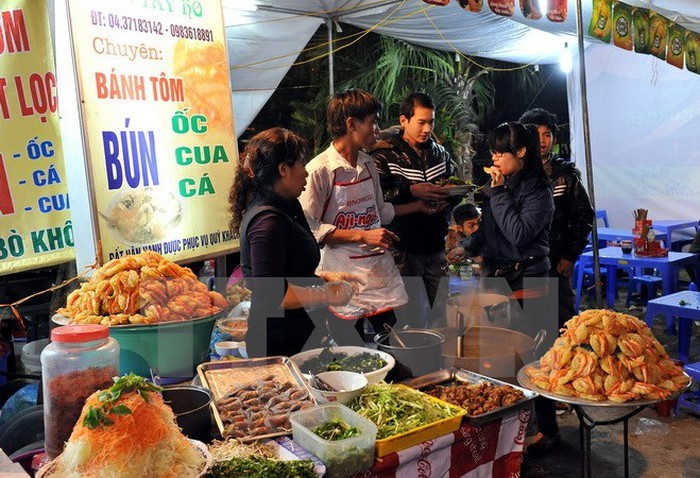 Shrimp cakes and snail noodles are sold on West Lake's bank. (Photo: VNA) Shrimp cakes and snail noodles are sold on West Lake's bank. (Photo: VNA) |
West Lake’s shrimp cakes are one of top seven specialties of Hanoi. Instead of grinding the shrimp into a paste (like a fish ball), it is usually left whole -- sitting atop a crunchy cake made of flour and sweet potatoes and then deep fried. These small, eye-catching yellow crispy cakes require meticulousness from the very first step of selecting ingredients.
Ngo Kim Dung, manager of the Huong Vi Viet restaurant, said: “Choosing high-quality ingredients is the most important step in shrimp cake making. We mix Hoang Long sweet potatoes from the northern province of Ninh Binh with flour to create the color, brittleness, and fullness of our shrimp cakes. West Lake shrimps are neither too big nor too small. They’re ideally sized, like a little finger, for placing atop the cakes.”
Shrimp cakes are typically served with lettuce leaves for wrapping, plus chili and fish sauce for dipping. Fish sauce is considered the soul of this dish, according to Mrs. Dung: “The fish sauce is a little sweet and a little sour. Hanoians typically don’t care for too salty or too sour. We often use vinegar instead of lime juice. The dish should be served with green papayas, not kohlrabi, because green papaya is crispier.”
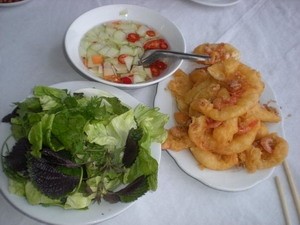 Shrimp cakes are served with herbs, fish sauce, and pickled green papayas. (Photo: VNA) Shrimp cakes are served with herbs, fish sauce, and pickled green papayas. (Photo: VNA) |
The cakes are usually deep fried upon the customers’ order to ensure they are fresh and brittle.
“Shrimp cakes are no strangers to Hanoians. I love the fresh ingredients which are harvested from West Lake in a very small volume each day. The shrimps are exceptionally tasty and the fish sauce is really mouth watering,” said visitor Vu Quynh Chi.
Shrimp cakes are served at the eponymous restaurant Banh Tom Ho Tay (West Lake Shrimp Cake) and many smaller restaurants near Tay Ho temple. Being drawn by the smell of fried oil and shrimps to enjoy a plate of the delicacy next to windy West Lake creates an in indelible memory.
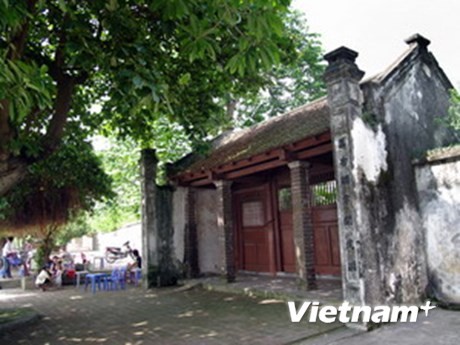 The three-door entrance gate to Trich Sai communal house. (Photo: VNA) The three-door entrance gate to Trich Sai communal house. (Photo: VNA) |
Trich Sai village on the bank of West Lake is one of six ancient villages in what is now Buoi commune, Tay Ho district, which has preserved its rich traditional culture and is closely connected to the history of Thang Long–Ha Noi. The village still has many old pagodas, temples, and shrines and a communal house.
“I’m proud to be a Trich Sai villager. We here still preserve our age-old traditions and have restored several features of the communal house, like the lobby and the three-door entrance gate,” said a village elder.
The Trich Sai communal house, built in 1612 during King Le Kinh Tong’s rule, faces east to welcome the sunrise over the lake. Nguyen Van Quang, the communal house’s caretaker, explained the village’s name: “The village used to be surrounded by a forest and local people earned their living by cutting firewood. ‘Trich’ means chop down and ‘sai’ means wood.”
The Trich Sai communal house was built in a typical majestic architectural style, with a rear chamber, a front chamber, a lobby, and a three-door entrance gate. It was once severely damaged but villagers contributed their own money to restore it.
“A number of paper archives were lost during wartime. We are now preserving two stone dragons which embody the typical architecture of the Ly dynasty. They stand in front of the communal house, whose ‘chuôi vồ’ architecture features a rear chamber honoring the village’s tutelary god,” Ly Ba Thang, chief manager of Trich Sai’s relic sites, told VOV.
For ages people have come to the Trich Sai communal house to worship a man named Muc Than who lived under the reign of King Ly Thanh Tong. Caretaker Quang told us the legend of Muc Than: “Muc Than was trained in martial arts and ethics. In 1076, while Muc Than was commanding a fishing fleet, the royal tutor Le Van Thinh transformed himself into a tiger, planning to kill the king, who was taking a stroll around West Lake, and seize the throne. Muc Than threw a fishing net into the sky and recited a mantra to foil the tutor’s association attempt."
"While returning home after reporting these events to the King, Muc Than leaned against an apple tree and all of a sudden, a tornado appeared and carried him up to heaven. The King honored him by making him Trich Sai’s tutelary god.”
The commemoration of the death of Muc Than at the Trich Sai communal house includes a worshiping ritual to remember the tutelary god’s contributions, an incense offering ceremony, a sports competition, and a chess game.
 Linh Buoi silk is made in the old day. (File photo) Linh Buoi silk is made in the old day. (File photo) |
The thousand-year-old Trich Sai village is famous for its Linh Buoi silk cloth. Legend has it that in the 15th century, the king sent one of his concubines, a Cham girl named Phan Thi Ngoc Do, and 24 maids to Trich Sai village. This concubine spent her own gold to build looms and taught the villagers how to grow mulberry trees, raise silkworms, and weave silk. The villagers are very proud of their craft.
“Trich Sai villagers are the best at making Linh Buoi silk cloth. We have generations of ‘golden hand’. We take great pride in this famous craft”, said a Trich Sai elder.
“I’m charged with taking care of the temple to honor Phan Thi Ngoc Do, the founder of Linh Buoi silk making. She was very kind to teach people this craft and save them from poverty. We will always remember her great merit,” said another female villager.
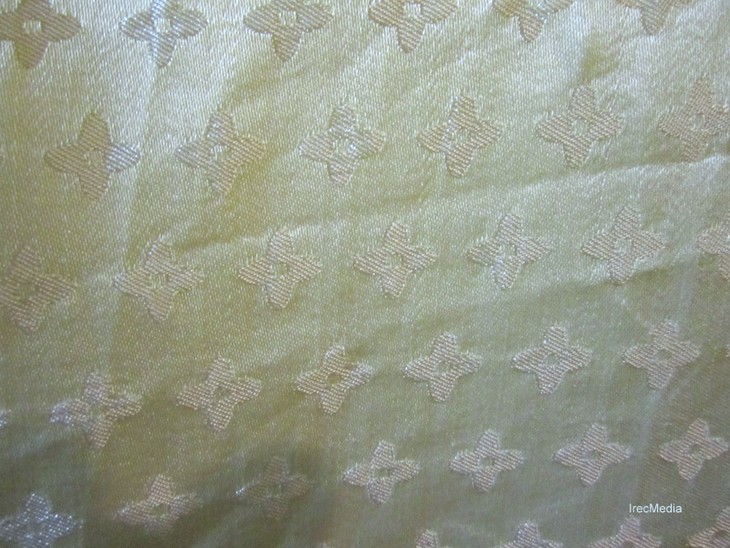 Linh Buoi silk with lemon flower patterns. (Photo: luaha.com.vn) Linh Buoi silk with lemon flower patterns. (Photo: luaha.com.vn) |
In the 19th and 20th centuries, Linh Buoi silk was considered the most luxurious and "stylish" fabric, used only for mandarins and wealthy families. Hanoi ladies showed off their rank by braiding their hair and donning clothes made from Linh Buoi silk. When wearing clothes made of Linh Buoi, the wearer can feel its light, non-sticky, non-creasing character. Its shiny, sleek lines enhance a woman’s curves. Linh Buoi weavers often create patterns inspired by nature – like lemon tree flowers and bamboo leaves.
After being taught the secrets of Linh Buoi silk making, the Trich Sai villagers prospered. To honor the great merit of Phan Thi Ngoc Do, after her death, the villagers set up a shrine to worship her, dubbed her the Linh Buoi weaving god, and began holding a festival on the 5th day of the first lunar month.
“On the night before the official festival day, young people gather to dance and offer lotus to Buddha and the Linh Buoi weaving god. The next day, different clans bring their offerings to Do. We the villagers then enjoy a food feast together," said Vu Thi Hoa, the caretaker of Phan Thi Ngoc Do temple.
The Linh Buoi silk cloth made by Trich Sai villagers was once very famous and exported. The people of Trich Sai long ago stopped weaving silk, but people are still aware that silk was once the pride of West Lake’s Trich Sai village.